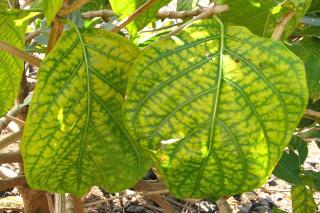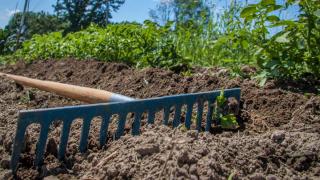

Nitrogen, phosphorus, calcium, iron… plants need nutrients to grow. Yellowing leaves might be due to lack of one of them!
Discover how to avoid iron deficiency and which treatments work to correct the resulting chlorosis.
Read also:
Chlorosis is a disease that reveals a nutrient deficiency for the plant. In fact, different types of chlorosis may impact various plants. Iron chlorosis is due to the plant not absorbing enough iron. There are two main causes. Either the soil itself doesn’t have enough iron it it, or the plant is having trouble harvesting the iron from the soil even if it’s plentiful there, for whatever reason. Often, gardeners mention that nitrogen, phosphorus and potassium are the key nutrients for plants to grow, but iron is also part of that short list! Indeed, the green pigment that chlorophyll uses to catch light includes iron as a crucial building block. Plants only need minute amounts of it, but they cannot survive without iron.
Grapevine, the peach tree, pear tree, rose tree, red currant and citrus are among the plants most vulnerable to this particular chlorosis. If you’re into herb growing, you’ll quickly learn that mint also hates chalky soil. You can add to this list all the heath plants that typically grow in highly acidic soil. When they’re grown in soil that is too alkaline, iron can’t enter their root system very well.
First of all, it’s important to check what specifically causes the problem. The deficiency occurs due to:
Where the ground is heavy clay, often waterlogged, it’ll be important to lighten the soil and help it drain better. Mixing sand into it helps a lot. However, if the soil is too dry, you’ll solve the problem with lots of mulch filled with organic material. Sometimes the solution lies in the plant itself: for rose trees and fruit trees, there are species that naturally grow well in lime soil. Use these as rootstock and graft the type of rose or tree you wish atop it.
Of course, best is to directly select plants suited to growing in lime, they’ll thrive! Do you love heath plants? Your best option is to plant in pots and containers. Potted plants will require regular doses of natural fertilizer, so mark it in your calendar. This is because soil mix can’t renew itself as soil in the ground can, so you need to be the one providing a fresh supply of nutrients from time to time.
Sometimes soil naturally has very low levels of iron. If that’s the case, you’ll have to enrich it through various organic options. Even though it might be tempting, refrain from using iron sulfate: it isn’t allowed in organic gardening. On top of that, using it is risky since it can irritate your lungs, eyes and skin.

